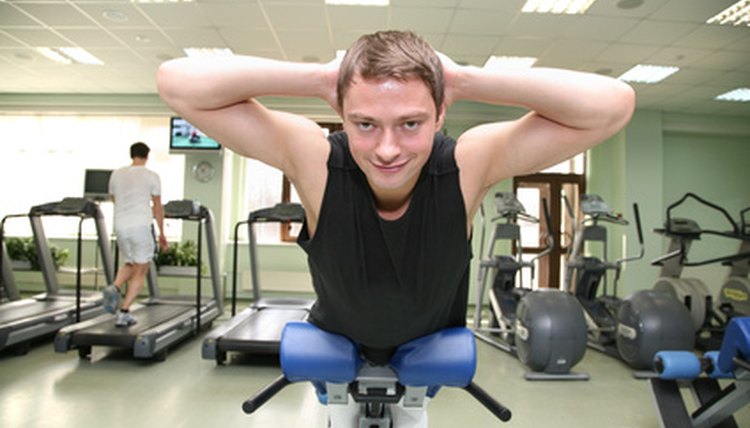The Disadvantages of Circuit Training

Circuit training consists of between six and 10 machines, where the person uses each machine, or station, for 30 to -45 seconds. They keep going around this circuit for 30 to 60 minutes, depending on the individuals goals. Some of the benefits to circuit training include getting the heart rate up quickly, sustaining it through the workout, and working several areas of the body in one session. However, there are also disadvantages to circuit training.
Speed of Workouts
Circuit training requires the person to switch machines, also called stations, every 30 to 45 seconds. If you are a gym member, it will be difficult to use the gym's equipment for this form of exercise. Most people at the gym use each machine for a varied amount of time. Cardiovascular machines are used for 30 minutes at a time. Other weight machines might be used for 10 to 30 minutes. So finding enough machines available when it is time to switch stations may be difficult.
Requires Expensive Equipment
Since circuit training is difficult to do at the gym, unless you belong to a gym specializing in circuit training, you will need to purchase the equipment to use at home. Buying each piece of equipment gets expensive and may not be worth the price you pay for the workout. You will need to purchase between six and 10 pieces of workout equipment for a successful circuit.
Space Required for Workouts
If you decide to do circuit training at home, you also will need a lot of space. Workout machines are large and heavy. For a successful circuit training area at home, it would require a large empty room, or the majority of your garage. The machines will fit around the room in a circle, leaving enough room to get in and out of each machine, and stretch when necessary.
Doctor Permission Required
As with any new workout routine, you should consult a doctor before beginning. With circuit training, because of the speed of the workout, people with high blood pressure or heart problems are not advised to use this method of working out. The person will need to be relatively healthy to begin with for circuit training, making this a big disadvantage for those people who are just starting their healthy lifestyle.
References
- Brian Mac: Circuit Training
- Wilke J, Kaiser S, Niederer D, et al. Effects of high-intensity functional circuit training on motor function and sport motivation in healthy, inactive adults. Scand J Med Sci Sports. 2019;29(1):144-153. doi:10.1111/sms.13313
- Feito Y, Heinrich KM, Butcher SJ, Poston WSC. High-Intensity Functional Training (HIFT): Definition and Research Implications for Improved Fitness. Sports (Basel). 2018;6(3):76. doi:10.3390/sports6030076
- Cardozo DC, DE Salles BF, Mannarino P, et al. The Effect of Exercise Order in Circuit Training on Muscular Strength and Functional Fitness in Older Women. Int J Exerc Sci. 2019;12(4):657-665.
- Mayorga-Vega D, Viciana J, Cocca A. Effects of a Circuit Training Program on Muscular and Cardiovascular Endurance and their Maintenance in Schoolchildren. J Hum Kinet. 2013;37(1):153-160. doi:10.2478/hukin-2013-0036
- McGlory C, Devries MC, Phillips SM. Skeletal muscle and resistance exercise training; the role of protein synthesis in recovery and remodeling. J Appl Physiol (1985). 2017;122(3):541-548. doi:10.1152/japplphysiol.00613.2016
- Shaw BS, Shaw I. Compatibility of concurrent aerobic and resistance training on maximal aerobic capacity in sedentary males. Cardiovasc J Afr. 2009;20(2):104-106.
- Chiara M, Chamari K, Chaouachi M, Chaouachi A, Koubaa D, Feki Y, Millet GP, Amri M. Effects of intra-session concurrent endurance and strength training sequence on aerobic performance and capacity. British Journal of Sports Medicine. 2005 Aug; 39 (8):555-60.
- Fleck SJ and Kraemer WJ. (2004) Designing Resistance Training Programs: 3rd Edition. Champaign, IL: Human Kinetics.
- Gettman LR, Pollock ML. Circuit weight training: a critical review of its physiological benefits. The Physician and Sports Medicine. 1981 9:44-60.
- Glowacki SP, Martin SE, Maurer A, Baek W, Green JS, Crouse SF. Effects of resistance, endurance, and concurrent exercise on training outcomes in men. Medicine and Science in Sports and Exercise. 2004 Dec; 36 (12):2119-27.
